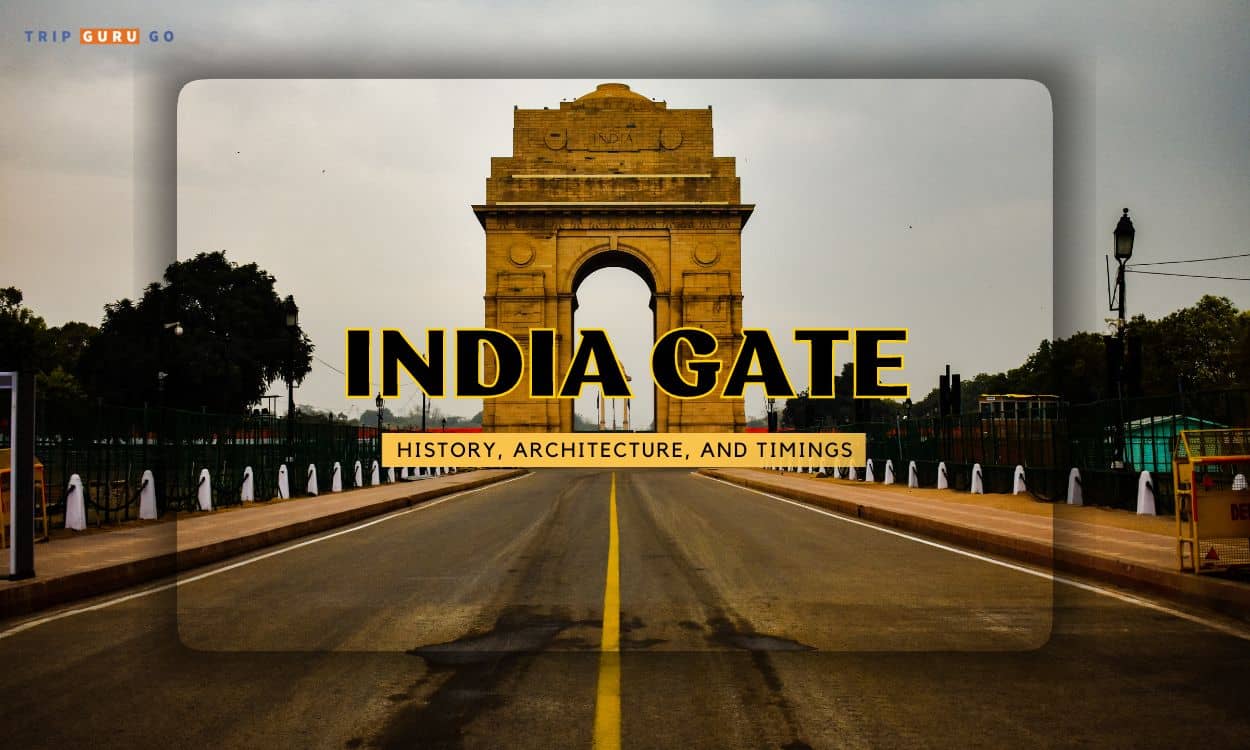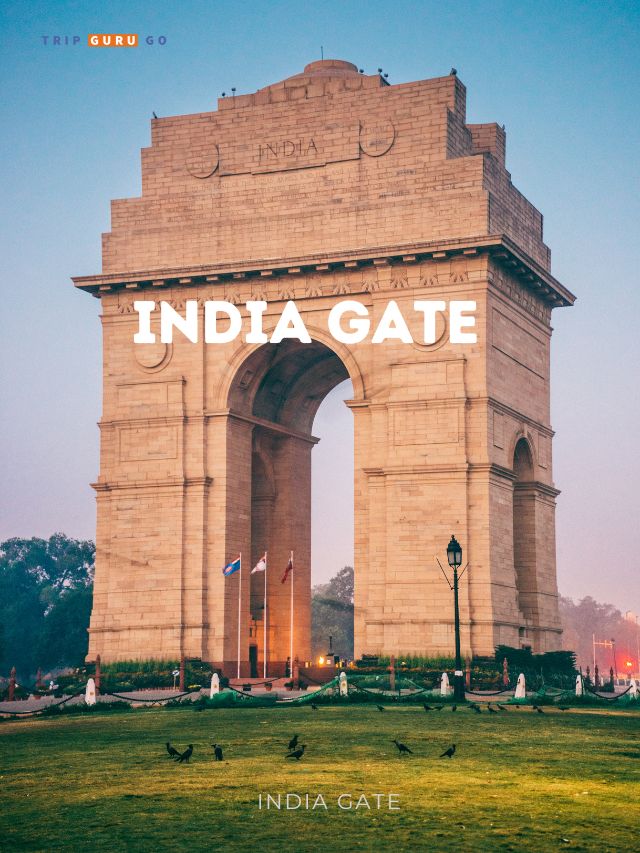Introduction
The India Gate, located in Delhi, is not just a beautiful memorial and place of worship that graces the city’s landscape. It is also a powerful symbol of the bravery, sacrifice, and unity of the Indian people in 2024. In the midst of New Delhi’s bustling streets, the India Gate tells a captivating story of heroism etched in stone. A tribute to the Indian Armed Forces, embodying unwavering spirit and national pride.
A. Brief History and Significance of India Gate
The India Gate carries a rich history, standing as a tribute to the brave individuals who faced danger with unwavering strength. Its origins are closely interwoven with a poignant and somber narrative. It stands as a construction that pays homage to the valiant sacrifices of the 84,000 soldiers of the Indian Army. These soldiers tragically met their end while gallantly fighting in the First World War and the Third Anglo-Afghan War between 1914 and 1921. The arch stands as a poignant reminder of commitment and sacrifice in India Gate’s history.
B. Importance as a National Monument
The India Gate is not merely a large structure. It is a national monument that represents the country’s values. The visionary architect Sir Edwin Lutyens designed it, drawing his ideas from the grandeur of memorial arches. It reminds people of famous landmarks like the Arc de Triomphe in Paris. Its beautiful archway and meticulously inscribed names honor the 13,300 servicemen. Among them are individuals from the UK, who will forever remain in our memories there.
As the sun goes down and casts a warm glow on its holy grounds, the All-India War Memorial becomes a symbol of respect. Its presence lights up the path to the Amar Jawan Jyoti, the Flame of the Immortal Soldier. This sacred flame, kept under the arch, symbolizes eternal gratitude. It pays tribute to the unknown warriors who sacrificed their lives for their country.
The India Gate is a historical guard at the formal center of New Delhi. It makes people think about the sacrifices made for freedom. It is a sign of India’s power and unity, and people of all ages are welcome to pay their thanks. It’s more than just a building; it’s a living symbol of respect that tells a story across time.
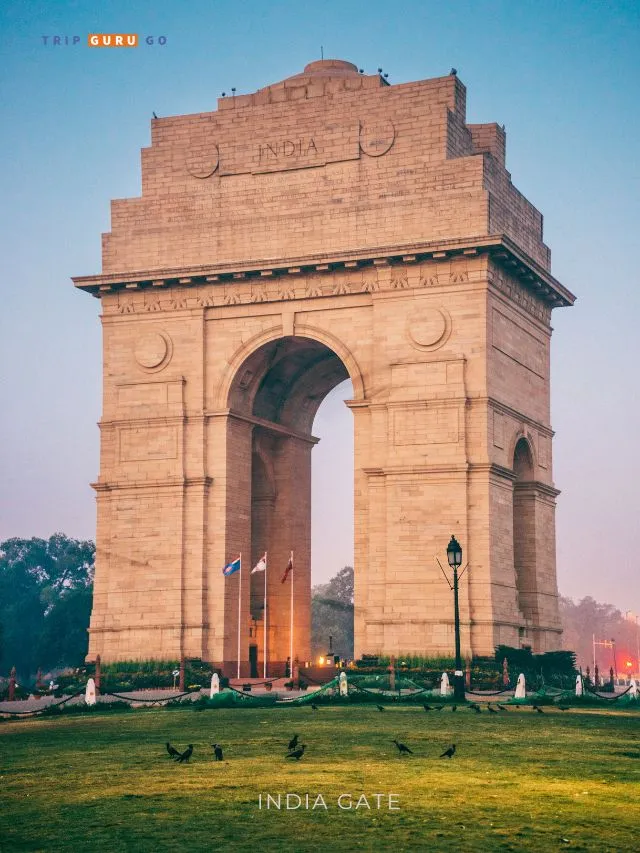
The History of India Gate
A. Commemoration of Indian Soldiers
The India Gate, steeped in history, stands as a solemn reminder of the sacrifices made by those valiant souls who laid down their lives for their beloved country. This iconic monument’s towering walls reverberate with tales of bravery and honor exhibited by Indian soldiers during pivotal moments in history.
The All-India War Memorial, a true testament to the unwavering dedication of these soldiers, serves as a tribute to their selfless sacrifices. It symbolizes the indomitable strength of their will and stands as a poignant reminder of their steadfast commitment that transcended borders and surpassed the ordinary call of duty. The India Gate History is a living chronicle of valor and sacrifice that will forever inspire generations to come.
B. Architectural Inspiration and Design
Sir Edwin Lutyens’s creative genius led to the creation of the India Gate, which stands as a beautiful piece of architecture. The gate’s design masterfully combines significant symbols with intricate details, resulting in a structure that echoes the architectural grandeur seen in memorial arches worldwide. Drawing inspiration from landmarks like Rome’s Arch of Constantine and Paris’s Arc de Triomphe, Lutyens created a timeless masterpiece. The India Gate’s architecture and design showcase his visionary approach, making it a captivating testament to history.
India Gate Architectural Features
A. Impressive Structure and Dimensions
Everyone who views the India Gate marvels at its impressive size and strength. With a height of 30 feet, it stands as a monument that reaches for the sky, which is a symbol of the soldiers it honors who had a spirit that reached for the stars. The base of the gate consists of red Bharatpur stone. The top of the gate features a striking shallow bowl with a domed apex designed to hold burning oil during special occasions.
B. Central Arch and Inscriptions
The most important part of the India Gate is its central arch, which has intricate carvings of the names of 13,313 servicemen. There are 12,357 brave Indian soldiers among them, and the gate also honors 70,000 Indian soldiers who died while India was still one country. These inscriptions honor sacrifice, urging passersby to remember the bravery these names represent.
C. Amar Jawan Jyoti – Flame of the Immortal Soldier
The Amar Jawan Jyoti, which is near India Gate, honors the soldiers who helped free Bangladesh in 1971. Black marble, reversed rifle, war helmet, and eternal flames pay homage. Indira Gandhi inaugurated it on 1972’s Republic Day. Guarded round-the-clock by armed forces, wreaths are laid on special occasions. In 2022, it merged with its counterpart at the National War Memorial, making sure that the tribute would last forever.
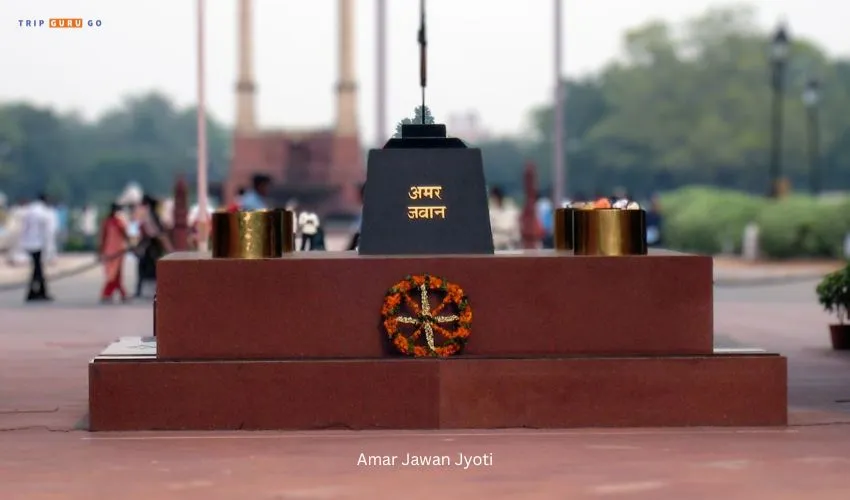
At the base of the India Gate is the Amar Jawan Jyoti, or the Flame of the Immortal Soldier. This is a powerful symbol of sacrifice that will last forever. This moving building, made of black marble, carries the weight of remembering. It shows that the soldiers who gave their lives for their country had a strong will to serve. The archway’s burning flames serve as a respectful reminder of every one of the sacrifices made.
As we learn more about the India Gate’s architectural beauty and historical importance, we start to understand its deeper meanings. The connection of design, purpose, and remembrance forms a lasting tribute, weaving honor, and gratitude, linking past, present, and future.
D. Inscriptions at the Top of the Gate
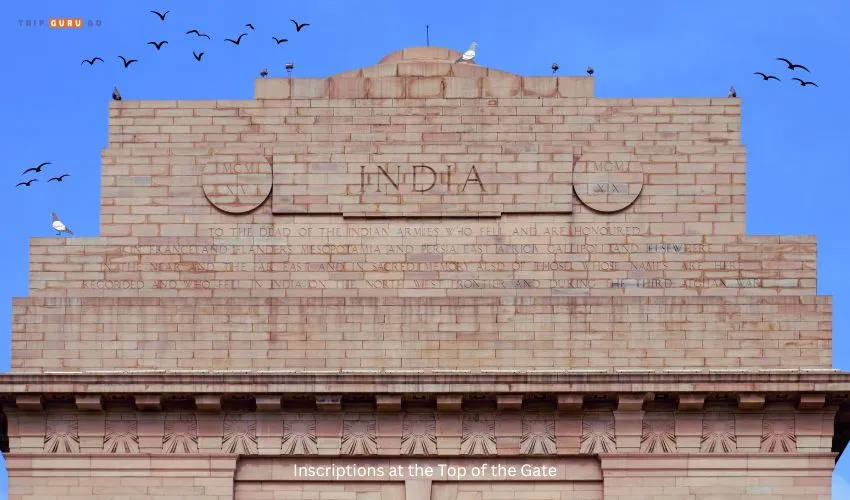
Even though the India Gate is beautiful and will always be, its cornice is a reminder of the past. The top is decorated with a row of imperial suns, and the sides of the arch are proudly written with the word “INDIA” and two important dates: “MCMXIV” (which means “1914”) and “MCMXIX” (which means “1919”). Still, the inscription below says more than anything else. It remembers the Indian armies who died in faraway places like France, Flanders, Mesopotamia, Persia, and more. Also, it honors the people who gave their lives on India’s North West Frontier and during the Third Afghan War.
The monument is a tribute to bravery, with 12,357 Indian names etched in solemn memory. It holds 13,313 names. Even though there is not much direct access, the Commonwealth War Graves Commission website keeps these names and stories of bravery and sacrifice alive for future generations. The India Gate represents not only a beautiful piece of architecture but also a story of bravery and commitment into the heart of the country.
E. Canopy Behind India Gate: A Timeless Symbol
Just 150 meters east of the India Gate, you will find the elegant canopy. It is a beautiful treasure that will draw you in. The history of this architectural masterpiece gives the story of the monument more depth. Made in 1952, the canopy stood guard over the George V statue. Edwin Lutyens combined history and art in a clever way by using Delhi Order columns to support the beautiful dome and chhajja.
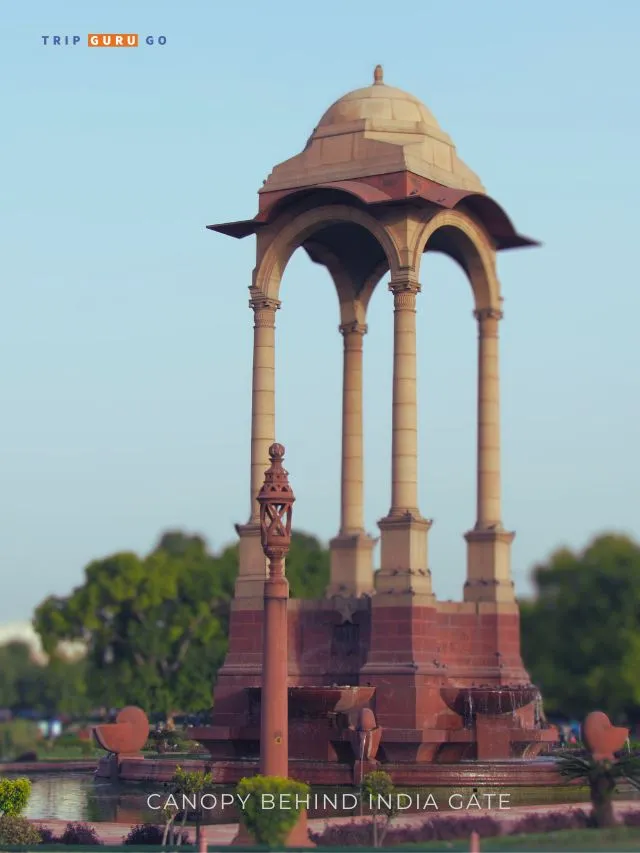
The 73-foot-tall canopy is more than just a beautiful structure; it also has echoes of a royal time. It held a statue of King-Emperor George V, which was a sad reminder of the past. During India’s fight for independence, the canopy stood strong and saw both acts of defiance and quiet thought.
Today, the canopy remains an emblem of endurance and evolution. It’s a silent sentinel, bridging history and modernity. As the sun’s rays touch its graceful curves, the canopy prompts reflection on the passage of time and the threads that connect us to our past. In the heart of the bustling city, the canopy whispers stories of resilience, inviting us to pause and listen to the echoes of history.
F.Subhas Chandra Bose Statue: Inspiring Valor
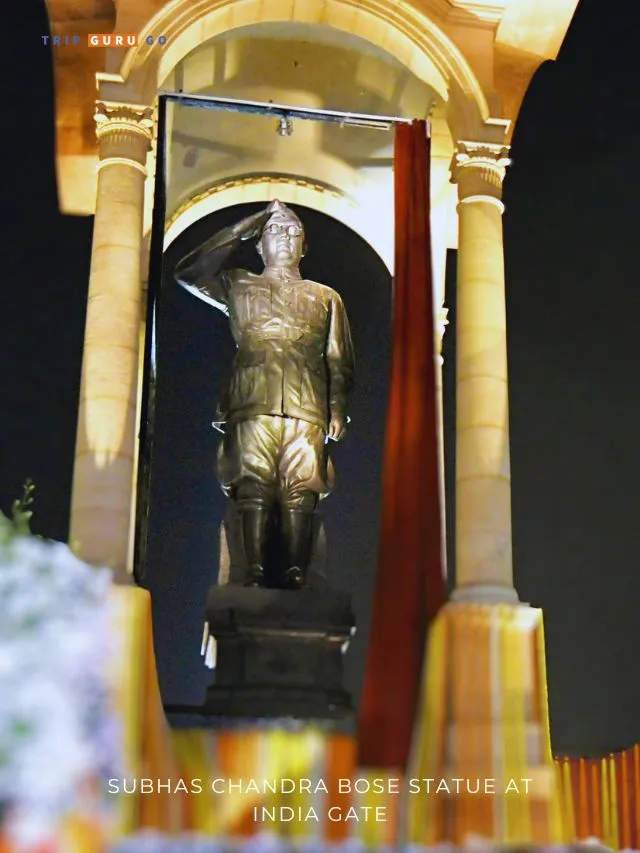
The statue of Netaji Subhas Chandra Bose was unveiled by Prime Minister Narendra Modi at India Gate on September 8, 2022. This was part of the opening ceremony for “Kartavya Path.” After announcing the plan to place a statue of Bose under the All-India War Memorial canopy on January 21, 2022, they unveiled the 28-foot-tall 3D holographic statue on Parakram Diwas, which took place on January 23, 2022. During this significant event, they also presented an award in Bose’s name for the best disaster management efforts. The statue is a reminder of how much Bose changed India’s history. It is a symbol of courage and patriotism. Its proximity to India Gate reflects how the nation continues to draw inspiration from the bravery of its people.
G. National War Memorial: Honoring Sacrifice
The National War Memorial (NWM) stands as a solemn tribute to the brave. It is part of the C-Hexagon. It reminds us of the sacrifices of heroes with the Amar Jawan Jyoti and a Netaji hologram statue. The NWM’s rings are shaped like a chakravyha, which stands for unity and strength. In 2014, plans for the NWM and an adjacent National War Museum, which would cost 500 crore, were made public. After being finished in January 2019, the NWM is now home to the “Flame of the Immortal Soldier,” or Amar Jawan Jyoti. This flame has been burning since January 2022 as a way to remember those who died in the war. This sacred place honors the unwavering commitment of those who fought for the country.
IV. Symbolism and Meaning
A. Tribute to the Fallen Soldiers
The India Gate stands tall not merely as an architectural marvel but as a profound tribute to the soldiers who made the ultimate sacrifice. Every part of its structure is a reminder of the brave people who gave their lives for their country. The names written on its walls are more than just words; they are stories of bravery, echoes of heroism, and the very definition of selflessness. Each name stands for a life spent protecting the sovereignty of the country, and the gate is a constant reminder of how much they cared.
B. Unity and National Pride
India Gate is more than just a monument. It is a sign of unity and pride for the whole country. People from all walks of life meet together to honor the sacrifices made by troops. The gate makes people feel proud of their history and ideals as a whole. People get together to pay their respects and renew their resolve to be one.
As the India Gate rises up in a majestic way, it means a lot more than just being there. It captures the deep feelings of thanks, sacrifice, unity, and pride that run through the nation’s heart. It connects the past to the present and asks us to remember, think about, and rededicate ourselves to the values that the soldiers died for.
V. Surroundings and Atmosphere of India Gate
A. Rajpath: The Path of Unity
Stretching gracefully from the India Gate to the Rashtrapati Bhavan, Rajpath forms a symbolic avenue that unites the heart of India. This path, which is surrounded by beautiful buildings and lush greenery, represents the journey of the country. Rajpath is a symbol of India’s unity, pride, and progress because it is where parades and processions take place.
B. Gardens and Recreational Haven
The area around the India Gate has more to offer than just history. It is a nice place to get some fresh air and relax. Green gardens and wide open spaces invite both locals and visitors to stop and enjoy the peaceful atmosphere. These green oases are a nice place for families to meet, couples to walk, and kids to play. In the middle of the busy city, the gardens offer a bit of nature and a place to think and relax.
Visitor Information for India Gate
India Gate is a must-see if you want to understand India’s history and sense of unity in 2024. In New Delhi’s ceremonial center, this monument tells stories from the country’s past.
- Opening Hours: The All-India War Memorial is open all the time, so you can go there whenever it is convenient for you. Checking the India Gate timings will ensure you make the most of your visit and experience its grandeur day and night.
- Entry: Entrance is free, which shows that the India Gate is open to everyone and is a symbol of unity.
- Best Time to Visit: In the evening, when the All-India War Memorial is lit up, it becomes a magical place to see.
- Visitor Experience: The lovely gardens that surround the All-India War Memorial provide people with a quiet place to reflect. People of all ages come together to pay their respects, creating a sense of community.
- Location: Centrally located in New Delhi, the India Gate is easily reachable via various modes of transport.
- Guided tours: If you want to learn more about its history, you can go on a guided tour led by an expert.
- Parking: There are easy parking options nearby, making sure that your visit goes smoothly.
- Food Points: Nearby restaurants offer a wide variety of dishes, so you can try out local flavors.
Visiting the India Gate is more than just a tourist attraction; it makes you feel connected to India’s sacrifices and peace. Whether you are a local who wants to think or a tourist who wants to learn about history, the All-India War Memorial welcomes you with open arms.
Nearby Attractions of India Gate
When you look around the area around the India Gate, you will find a treasure trove of cultural landmarks and experiences that add to the historical importance of the monument.
- Rashtrapati Bhavan: The President of India lives in the beautiful Rashtrapati Bhavan, which is right next to India Gate. Its beautiful architecture and large gardens show how the country has been run and what it stands for.
- Rajpath: Rajpath is a ceremonial street that goes from India Gate to Rashtrapati Bhavan. It is lined with beautiful gardens and famous landmarks. It is a route that feels like a parade or celebration of the country.
- National Gallery of Modern Art: Art lovers can go to the National Gallery of Modern Art, which has an impressive collection of modern and contemporary art from Indian and international artists.
- Parliament House: India’s Parliament House, situated not too far away, boasts a distinctive round shape and serves as the locus of democratic decisions. Its splendid architecture vividly showcases the efficient governance of the nation.
- Crafts Museum: The Crafts Museum has a wide range of traditional artifacts and handcrafted treasures that show India’s rich craft history.
As you visit these nearby places, you can feel the spirit of India’s history, culture, and hopes. This creates a rich tapestry that makes your trip to India Gate even better.
Explore the best places to visit in Delhi and uncover its rich history and culture.
Reaching India Gate: Easy Access through Nearby Transportation
When it comes to reaching India Gate in 2024, there are several convenient transportation options to choose from. Here’s a guide to help you get to this iconic monument:
- Nearest Metro Station: If you’re planning to take the metro, the nearest station to India Gate is the Central Secretariat Metro Station. This station is located on the Yellow Line of the Delhi Metro network. From Central Secretariat Metro Station.
- Distance from the nearest metro station: Central Secretariat Metro Station is about 2.3 kilometers from India Gate. It is a short, pleasant trip that lets you take in the scenery as you head to this important historical site.
- Nearest Railway Station: For those arriving by train, the nearest major railway station is the New Delhi Railway Station. From there, you can opt for local transportation options like taxis, buses, or cabs to reach you conveniently.
- Buses and taxis: The Delhi Transport Corporation (DTC) has many bus routes that go to India Gate from different parts of the city. You can also hire a taxi or book a cab through a ride-sharing app, which will make sure you get to your destination safely and comfortably.
Getting to India Gate in 2024 is easy with these options. Whether by metro, bus, or taxi, reaching this historic site is hassle-free. The nearby metro station makes visiting the All-India War Memorial even more convenient.
Conclusion
In conclusion, India Gate stands tall as a symbol of India’s rich history and unity. Its majestic presence honors the sacrifices of soldiers and commemorates important events. As a popular landmark, it continues to attract visitors from around the world, providing a space for reflection and appreciation. Whether by day or night, India Gate’s grandeur leaves an indelible mark on all who witness its grandeur
FAQs
India Gate is popular because it is a national memorial to the soldiers who died in World War I and the Afghan Wars. It is also a sign of bravery and pride.
The original name of India Gate is “All India War Memorial.”
Yes, India Gate is open to visitors at night. It is beautifully illuminated and offers a serene atmosphere.
The metro station nearest to India Gate is the “Central Secretariat.”
No, climbing is not allowed to maintain its preservation and respect.
Yes, visitors can enter the India Gate complex without any entry fee.
India Gate doesn’t have an interior accessible to the public; it’s a memorial structure.
On top of India Gate, the words “Amar Jawan” are inscribed, meaning “Immortal Soldier.”
India Gate was completed in 1931, making it over 90 years old.
We like India Gate because of its history, architecture, and the way it makes us feel as a tribute to our troops.
There is no “king” associated with India Gate. It was designed by Sir Edwin Lutyens as a memorial for soldiers.

